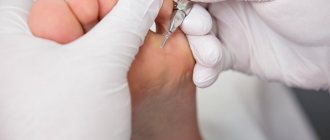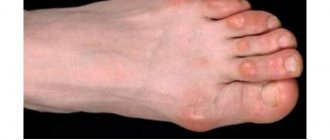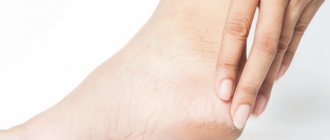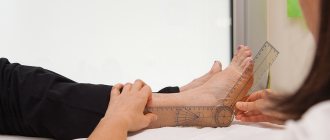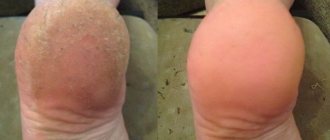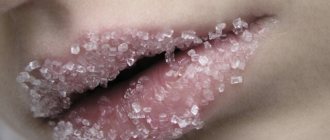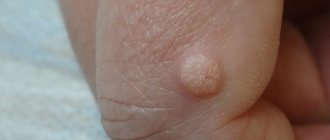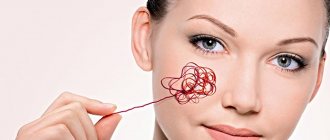What is a callus?
Corns/ACFAS callus is a convex, dry callus with a hard core, also called a root or shaft.
At first the rod may be small, but over time it grows and goes deep into the skin. Callus causes pain when walking Kevin M. Pennycook; Tess A. McCready. Clavus/StatPearls Publishing, like he stepped on a pin. The deeper the rod grows under the skin, the stronger the discomfort.
But this is not the only problem.
Prevention
It is impossible to identify and eliminate all provoking factors for the formation of callus. However, careful attention to your health, moderate physical activity, a healthy lifestyle, and timely treatment of concomitant foot diseases reduce the risk of dry callus formation.
It is important to take all measures to prevent calluses from appearing:
- choose comfortable shoes with a maximum heel height of 3–4 cm;
- normalize weight;
- adjust the load on the feet and hands;
- When working with tools, sports and gardening equipment, use protective gloves;
- remove dry calluses in a timely manner;
- Avoid walking on the ground barefoot and getting in contact with foreign bodies.
If the problem of changing the arch of the foot already exists, orthopedists recommend strengthening the muscles of the feet and legs with the help of massage and exercise therapy, avoiding statistical overload, and wearing orthopedic insoles.
Why is callus dangerous?
If you endure the pain and do nothing about such a callus, its core will continue to grow. And then it can damage Corns (Clavus) Clinical Presentation / Medscape soft tissues and nerve fibers along the way.
Sometimes this leads to serious inflammation. It can cause ulcers on the skin. And if the inflammation affects the bones, septic arthritis or osteomyelitis will develop.
The risk of such complications increases sharply if a person has diabetes, problems with blood circulation in the legs or immunity.
Features of the problem
A callus with a core has smooth and clear edges, as well as a yellowish-flesh color. Quite often it is called ingrown.
This type of skin growth is considered the most difficult and unpleasant to treat. The callus grows deep into the subcutaneous tissue, causing severe pain. Many dermatologists consider callus to be a type of hard callus and a late stage of its development. A dense rod, which looks like cartilage, is formed due to rapid cell division.
When you press on a callus with a rod, a very strong dull pain occurs, as the nerve fibers are compressed.
Where does callus come from?
All dry calluses, including core calluses, appear for one reason Corns and calluses / Mayo Clinic: something is rubbing or pressing on the skin. This could be, for example, uncomfortable shoes. Or perhaps you simply put excessive stress on your feet by walking barefoot on a hard surface or forgetting to wear socks under unworn shoes.
Due to prolonged mechanical pressure, the skin cannot shed old cells. They accumulate on the surface, compress and turn into a dense keratinized layer - a dry callus. The longer the epidermis is under stress, the denser and more noticeable the corns.
There is only one difference between an ordinary dry callus and a core callus. In the first case, the pressure on the skin is distributed over a more or less extensive area, for example, over the entire heel, and in the second, something presses on a specific Corns (Clavus) point. Overview/Medscape. Therefore, the area of compressed skin is small in size and grows deeper, turning into a callosal root.
Main symptoms
The presence of a dry callus with a core can be determined by the following signs:
- unpleasant and painful sensations are observed;
- often growths form near the thumb or little finger;
- An ingrown callus greatly interferes with a person’s ability to walk normally.
At the initial stage of the appearance of such corns, a person feels a slight tingling in the area of their formation. The injured area itches quite often.
Similar symptoms are also typical for ordinary calluses, but if they are core calluses, then when the stratum corneum is removed, you can see the root, which looks like a small dark spot and remains in place. This rod causes pain when moving. For this reason, removing dry calluses with a core is a rather complicated procedure.
How to find out that it is a core callus and not some other one
Sometimes it can be difficult to tell if the corn that's bothering you has a stem. Focus on several characteristic signs of a callus.
Location
Most often, calluses occur where the skin is not accustomed Corns and calluses / Mayo Clinic to stress. For example, on the lateral and upper surfaces of the toes, in the interdigital spaces of the feet. Sometimes the palms suffer: for example, among those who overworked the barbell.
In other places, core callus, although possible, is unlikely.
Dimensions and shape
Unlike a corn, which can have a variety of shapes, a callus is always round, small and convex. It looks like a grain of corn that has entered the skin. In the English-language medical literature, this type of callus is called corn (“corn”).
A small round depression in the center of the callus
This is how the visible part of the rod manifests itself. Please note that if the callus has formed on the top side of the fingers, the indentation may be almost invisible.
Photo: Migren art / shutterstock
Photo: sruilk / shutterstock
Pain when pressing
A common dry callus may be uncomfortable, but it doesn't hurt. If you feel pain when you press on the corn, most likely it has grown a stem.
When to go to the doctor
Contact a podiatrist or dermatologist experienced in treating calluses if:
- You have diabetes, circulatory problems or heart disease Corns and calls / NHS. Attempting to get rid of the callus on your own in such cases can quickly lead to complications.
- The callus appears inflamed Corns and calluses / Mayo Clinic. It hurts you to even touch it, let alone press it. All this may be a sign of inflammation that has already begun deep under the skin.
You should also see a doctor if you have tried to get rid of the callus with home remedies, but the affected area still continues to cause discomfort.
Corns on the feet: case studies
Callus in an uncharacteristic location
Wart above, papillary callus below
Two core calluses located side by side
After using anti-corn medications
How to remove callus at home
Experts at the Mayo Clinic Research Center suggest Corns and calluses / Mayo Clinic the following methods. You can choose one or combine several at once.
Take a warm bath and use a pumice stone
Experts from the American Academy of Dermatology recommend How to treat corns and calluses / AAD to immerse your foot or hand in warm water for 5-10 minutes. This is necessary for the skin to absorb moisture and become softer.
Then moisten the pumice stone in the same water and, using gentle circular movements, try to remove the stratum corneum. Do not press too hard so as not to rub the skin until it bleeds.
Under no circumstances use sharp objects to pull out the rod: you risk introducing an infection into the wound.
It is unlikely that you will be able to get rid of callus using baths in one day. The procedure will have to be repeated at least 2-3 times.
Use moisturizer
It will help retain moisture in the skin. Thanks to this, the layer of dead skin will become looser and begin to peel off.
It is best to apply the cream after a bath. To consolidate the effect, put on cotton socks or a glove on top if a callus has formed on the palm or finger.
Buy a special patch
Pharmacy plasters for calluses contain a lot of salicylic acid. This substance destroys Tasleem Arif. Salicylic acid as a peeling agent: a comprehensive review / Clinical, Cosmetic and Investigational Dermatology bonds between epidermal cells and makes the callus looser, making it easier to remove.
The patch is applied to the callus and changed from time to time - as often as stated in the instructions.
When using the patch, try to ensure that the active part does not touch healthy skin. Salicylic acid can damage it. This is especially dangerous Corns and calluses / Mayo Clinic for people with diabetes or other conditions that impair blood flow: bacteria that enter the wound can lead to a serious infection.
Use other anti-callus products
In pharmacies you can buy creams with salicylic acid, ammonium lactate or urea. These ingredients break down the bonds between dead skin cells and cause them to slough off.
How to remove a callus with the help of a doctor
A podiatrist or dermatologist will examine the callus, assess its location and the depth of the core. And depending on this, Ahmad M. Al Aboud will offer you treatment; Siva Naga S. Yarrarapu. Corns/StatPearls Publishing. This can be a hardware pedicure, in which the stratum corneum is first loosened using various means, and then the shaft is drilled out with a special cutter. The same operation can be done using a laser or scalpel.
There are other methods, for example cryodestruction - removal of callus using liquid nitrogen. But this is a somewhat questionable method, since nitrogen damages Ahmad M. Al Aboud; Siva Naga S. Yarrarapu. Corns / StatPearls Publishing and normal skin. Because of this, the wound takes longer to heal. In addition, it has been noted that with this treatment, calluses can quickly form again.
Forecast
Callus is a condition that can be cured much better if treatment is started as early as possible. If pharmacy or non-traditional local remedies do not help, then you can remove the growth if you promptly contact a specialist who will select the optimal physiotherapeutic or surgical method of treatment. It is important to take into account all the features of the callus, namely its size, area of localization, and severity of symptoms.
You should not delay removing the core growth, since at an early stage you can get rid of it permanently quite quickly, without resorting to the help of specialists. With proper and timely treatment, the prognosis is generally positive.
What to do to prevent calluses from appearing
The answer is obvious: do not put excessive pressure on the skin. This is what the experts of the American Academy of Dermatology advise How to treat corns and calluses / AAD.
Wear comfortable shoes
Incorrectly selected shoes - too tight or loose on the foot - are highly likely to lead to the development of calluses, including core ones.
Cut your nails on time
Due to too long nails, the toes do not fit into the shoes and become bent. In this case, even shoes or boots chosen to fit begin to press.
Use special shoe pads
Silicone gaskets or patches can be purchased at any pharmacy. They are attached to problem areas in shoes or on the leg and thus protect the skin from excessive pressure.
